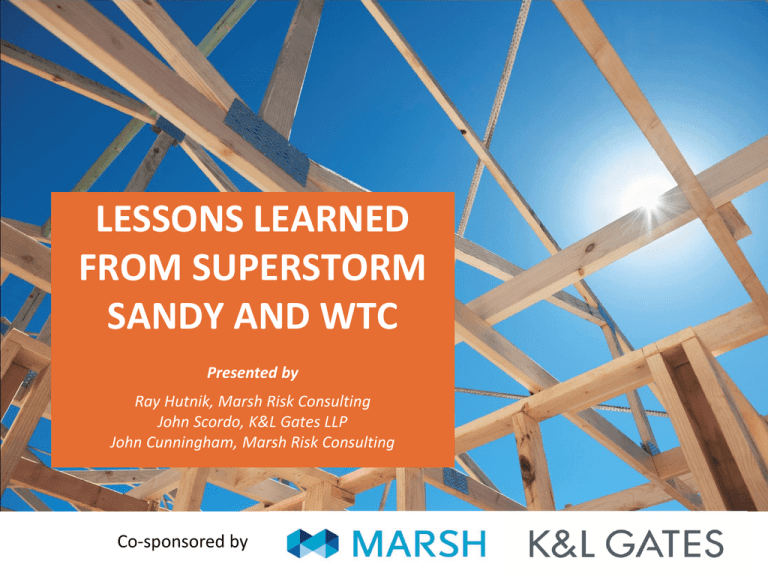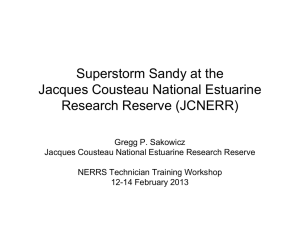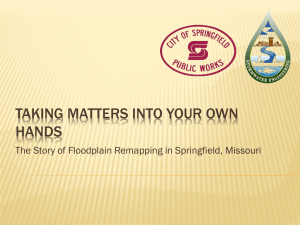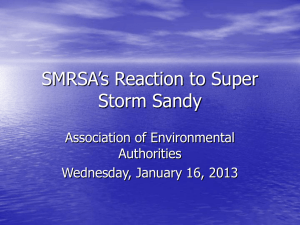
LESSONS LEARNED
FROM SUPERSTORM
SANDY AND WTC
Presented by
Ray Hutnik, Marsh Risk Consulting
John Scordo, K&L Gates LLP
John Cunningham, Marsh Risk Consulting
Co-sponsored by
Lessons Learned From Superstorm Sandy
and WTC
Our Proposed Agenda
Our Perspective – Accounting/Forensic, Engineering & Legal.
Superstorm Sandy and WTC.
Market response/issues.
Causation issues.
Coverage issues.
Claims management.
Recovery from various policies.
Measurement issues.
Overview of the Property Claims Process.
Pre-loss preparedness.
Post-loss activities.
Buckets of coverage.
1
Lessons Learned From Superstorm Sandy
and WTC
What Perspectives Do We Represent?
Coverage expertise.
Negotiation and interaction with insurers.
Quantum.
Claims preparation.
Interacting with insurers’ experts.
Liaison to Risk Management Department.
Claims project management.
Litigation/Arbitration preparation and prosecution.
2
Recent Catastrophic Losses
A Sign of Things to Come?
2012 was a quiet year…until
Superstorm Sandy
Q4 2012
3
Superstorm Sandy
Market Response
More named storm deductibles likely to become a
percentage deductible regardless of geographic
location.
Capacity to staff enough adjusters to respond being
tested.
Quantum and complexity of losses resulting in
widespread usage of outside experts.
4
Superstorm Sandy
Threshold Issues
Direct loss vs. financial loss.
Time element.
Service Interruption issues: Power outages in New York
caused by storm damage vs. planned shutdown. Overhead
transmission and distribution issues elsewhere.
Contingent Business Interruption (CBI) issues: Drove need
to carefully document specific reasons
customers/suppliers may have been interrupted: damage,
civil authority, ingress egress, service interruption, etc.
5
Superstorm Sandy
Damage to Insured Property
Repair or replace the damaged property and:
Business Interruption.
Extended Business Interruption.
Extra Expense.
Interdependency Extra Expense.
Claims preparation costs.
6
Superstorm Sandy
Damage to Third-Party Property
Prove that there is damage to a third-party’s
property and:
Business Interruption and Extended Business Interruption.
Service Interruption.
Civil/Military Authority.
Ingress/Egress.
Contingent Extra Expense.
7
Superstorm Sandy
Causation Issues
Insurance policies have varied terms and conditions. When
discussions on coverage occur with insurers, they must have
reference to specific terms and conditions of your policy.
Losses may be tied to any number of causes:
Direct action of wind.
Storm surge.
Service interruption.
Flying debris.
Ingress/egress.
Surface water.
Overflow of rivers and waterways.
Civil authority.
8
Superstorm Sandy
Flood Issues
Much debate over storm surge vs. flood vs. wind in
2005, post-Katrina.
Policy definitions of storm surge as flood or
windstorm vary. Careful analysis is necessary. Can
affect cover, limits, and deductibles.
9
Superstorm Sandy
Flood Issues (cont.)
Sandy claims are in active debate over storm surge
vs. flood vs. wind as opposed to Irene in 2011, which
was more of a rain flooding event.
Each policy will have its unique issues.
For example, the peril of flood is more often sublimited on a policy
than is the peril of wind.
Insureds may have traded pricing or other coverage
for how the peril of storm surge will be defined.
10
Superstorm Sandy
Additional Flood Issues
Some insureds do not realize they have a general
flood sublimit and then a smaller sublimit for the
problem areas.
As defined by FEMA’s flood maps: The 100-year-flood
zones, also know as zones “A” and “V” or Special Flood
Hazard Areas.
Not uncommon on a commercial risk to see a flood limit of
“X” along with a further sublimit of one-fifth of “X” for
zones “A” and “V.”
11
Superstorm Sandy
Additional Flood Issues (cont.)
Important for insureds to know their sublimits and
which locations are in problem zones.
FEMA redraws these maps occasionally.
A location that was not in an SFHA zone at renewal might
now be in one.
12
Superstorm Sandy
Named Storm Deductibles
Most commercial insurance policies refer to “named
storm” or “named windstorm.”
Can be complicated. Definition of named storm: “Storm or
weather condition declared by NWS as a hurricane or
tropical storm.”
Typically, named storm deductible is a percentage of the
replacement cost of the location damaged, typically 2% to
5% depending on the location.
There may also be a maximum or a minimum on the dollar
value of the percentage amount.
13
Superstorm Sandy
Named Storm Deductibles (cont.)
Typically applied to locations in counties referred to
as “Tier One Counties.”
Percentage deductibles also apply to business
interruption.
14
Superstorm Sandy
Business Interruption
Business interruption (BI).
A subset of time element.
Many unique extensions of coverage.
Large portion of the expected losses may arise from BI:
service interruption, leader property, civil authority,
ingress/egress.
15
Superstorm Sandy
Business Interruption (cont.)
Lessons from the 2011 Japanese earthquake and
tsunami and Thai floods.
Some clients have since calculated their expected BI and
CBI exposure.
Other companies have put together business
continuity plans based on identified weak spots
and/or critical processes.
16
Superstorm Sandy
Coverage and Legal Considerations
In the definition of flood in the policy, what is the scope
of the coverage?
Are there distance limitations and requirements of
property damage for ingress and civil authority
coverage?
For service interruption, are there distance limitations?
Are there qualifying periods, such as 24, 48, or 72 hours?
When you look at employee availability, how will it
impact indemnity periods?
How does pre-loss evacuation impact an insurer’s
position on business interruption coverage?
17
Superstorm Sandy
Coverage and Legal Issues
Cause of loss: wind or flood?
Concurrent causation – is there an anti-concurrent
causation clause?
Business interruption or contingent business
interruption.
Suppliers and customers – direct or indirect?
Suspension or reduction of operations.
Calculating business interruption losses.
18
Financial Recovery Considerations
Additional Cost of Operations
Extra Expense.
Third-party costs.
Embedded internal costs.
Expense to avert BI.
Increased cost of work (ICOW).
Additional ICOW.
Increased cost of construction (builders risk).
“Pure” extra expense.
Expediting expense.
19
Financial Recovery Considerations
Reconstruction
Rebuild considerations.
Resource availability (labor, materials, equipment).
Cash flow requirements and considerations.
Rebuild contracting strategy.
20
Financial Recovery Considerations
Reconstruction (cont.)
Insurance policy considerations.
Limits and sublimits.
Replacement cost value vs. actual cash value policies.
“Period of restoration.”
Like kind and quality.
Code requirements.
Time limits.
Builders risk loss scenarios.
21
Financial Recovery Considerations
Rebuild Considerations
Demolition, increased cost of construction.
DICC or Code Coverage.
“Capital expenditure” options.
Not planned as of date of loss.
Usual to the insured’s operations.
At an insured location.
Completed in two years.
22
Replacement Cost vs. Actual Cash Value
ACV is an option for cash payment.
ACV = Replacement Cost – Depreciation.
Depreciation is NEITHER book NOR tax depreciation.
Effective age.
Typical life
expectancy.
Standard tables.
23
Repair vs. Replace
WTC Disaster
BI coverage for a “direct physical loss or damage” to
the property.
Nature of “damage” – may not be easily visible or in
dispute (e.g., noxious particles in interior of buildings
following 9/11).
24
Claims Process
Is There an Imbalance?
Insured
Risk Manager
Insurer
Loss Adjuster
Engineer
Accountant
Lawyer
25
How to Even the “Balance of Scales”
Insured
Risk Manager
Marsh Risk
Consulting
K&L Gates
Insurer
Loss Adjuster
Engineer
Accountant
Lawyer
26
Role of Insured’s Risk Manager
Coaches and quarterbacks.
Directs and controls all communication and
exchange of information.
Identifies internal key contacts and delegates to
team.
Takes ownership.
27
Managing the People
Agree to loss management and communication
protocols early, ideally before loss occurs.
Define roles, responsibilities, and deliverables with
specific time frames.
28
Managing the People (cont.)
Plan for empowered personnel from all parties of
interest:
Adjusters.
Forensic accountants.
Building and engineering consultants.
Restoration contractors.
Insured’s engineering community.
Human resources.
Risk management.
Financial community.
Public relations.
Legal.
29
Managing the People (cont.)
Meet insurer decision makers as soon as possible
post loss.
Help the insurer understand the policyholder's
financial and operational goals.
Get the insurer to agree on a “funding" protocol
early in the claims process.
30
Your Duties as the Insured
Prepare the claim.
Demonstrate conditions found.
Link damages back to the event (show causation).
Show work done and why it was like kind and quality.
Justify replacements (vs. repair).
Make good business decisions, regardless of
coverage.
Involve the adjuster.
31
Claims Management
WTC Disaster
Record keeping.
Privilege.
Chain of custody.
Documentation.
Bidding and work processes.
32
Expedited Payments
Fundamentals.
Adjuster must become comfortable with scope and estimate of
loss.
This is not a requirement.
Some carriers are more forthcoming than others.
Best ways to achieve:
Develop a good rapport with adjusters by actively helping them.
Give adjusters easy but escorted access to the loss sites. Have a
member of your claim/recovery team escort them.
Prepare a preliminary estimate of the loss and present it to the
adjuster.
Provide quotes, invoices, and purchase orders.
33
Expedited Payments
Expect questions about the preliminary loss estimate.
Answer all questions.
Help your adjuster better understand the claim.
Expect no advance payment against estimated business
interruption claims.
Concentrate efforts on losses related to fixed assets, clean
up/restoration costs, and inventory.
Making a formal request for an advance will force the insurers
to respond.
34
Managing Sublimits
Examples of sublimits:
Expediting.
Temporary services.
Demolition, increased cost of construction.
Claim preparation.
Adjuster is trained and motivated to shift as much of
your loss as possible into categories with sublimits.
Expect your experts to be likewise trained and
motivated to maximize your total recovery.
35
Professional Fees Coverage
(AKA “Claim Preparation”)
Typically included as a specific sublimit.
Claim preparation consultants.
Reasonable and necessary.
Put your architect, engineering, and outside
estimator’s expenses into the cost of recovery, NOT
in claim preparation.
36
Preparing for the Unpredictable
Ensuring That Losses Are Fully Recovered: Step One
Work with your broker, claim advocate, and attorney and
confirm that policy coverages and limits for your property and
potential loss of income are sufficient.
How accurate are your reported values for property and business
interruption?
Test your business income limits, and calculate your anticipated
maximum business interruption loss (AMBIL) amount for key
locations.
Are deductibles too high (flood, EQ, wind)?
Are limits and sublimits sufficiently high (property, BI, service
interruption)?
Are Contingent Business Interruption coverages in place for both
direct CBI and indirect CBI events.
Exclusions, waiting periods, valuation considerations.
37
Preparing for the Unpredictable
Ensuring That Losses Are Fully Recovered: Step Two
Have your team in place.
In-house team:
Risk manager.
Claims manager.
Safety manager.
Corporate counsel.
Operations, finance, IT.
Outside experts:
Claims advocacy.
Forensic accounting.
Claims engineering.
Legal.
38
Post-Loss Activities
Initial Steps for Obtaining Financial Recovery
Perform initial damage assessments.
Inspect loss site.
Photograph and video extensively to capture extent of damages.
Inventory damaged items.
Obtain quotes of replacement cost or repair costs.
Your experts can often spot hidden damage and are alert to code
issues.
Create overall estimate of loss, claim books.
Present estimate to adjuster, walk them through it.
Adjuster sets reserves.
Adjuster processes advance payment.
39
Communicate, Communicate, Communicate
Communication cannot be overemphasized.
Establish communication guidelines with the entire
claims management team.
All insurer/insurer rep site visits should be monitored.
40
Communicate, Communicate, Communicate
(cont.)
Communication with insurers is critical.
Engage them early regarding projected cash need.
A claim is a very dynamic process – unanticipated issues
inevitably arise.
Effective communication can prevent a small issue becoming a
significant problem.
Immediate notice of loss.
41
Communicate, Communicate, Communicate
(cont.)
Communication with insurers is critical (cont.).
Provide as much information as possible regarding:
Extent of damage.
Impact on the business.
Immediate steps being taken to manage the loss.
Many decisions are made early in the process – need to be
communicated and made jointly.
42
Measurement of the Loss
Maximize Recovery by Allocating to the Right Buckets
Physical damage:
Buildings, equipment, inventory.
Sublimits: debris removal, expediting.
Exclusions: nuclear, environmental.
Time element losses:
Business Interruption/mitigating costs.
Inefficiencies and additional costs to
operate = extra expenses.
Time element extensions:
Extended period of indemnity.
Contingent time element/contingent business interruption (CBI).
Service interruption.
Ingress/egress, possibly civil and military authority.
43
Loss Measurement and Documentation
You Will Be Asked for More Documents Than You Can Ever Imagine!
Detailed budgets and proposals.
As-was repairs vs. betterments.
Hypothetical as-was repair timelines.
Detailed invoices.
Receipts and expense reports for
out-of-pocket expenditures.
GL accounting detail and POs.
Production, sales, inventory data.
Operating statements (forecast and actual).
DOCUMENTATION IS KEY!
44
Financial Recovery Considerations
BI - “3-Step Method”
Calculate lost sales.
Reduce lost sales to lost gross earnings.
Deduct non-continuing operating expenses.
45
Gross Earnings Less Non-Continuing vs. Net
Income + Continuing Loss Calculations
Projected
Actual
Loss
Revenue
$10,000,000
$0
$10,000,000
Cost of Sales
($7,000,000)
$0
($7,000,000)
$3,000,000
$0
$3,000,000
Variable
$1,000,000
$0
$1,000,000
Fixed
$1,500,000
$1,500,000
$0
$2,500,000
$1,500,000
$1,000,000
$500,000
($1,500,000)
$2,000,000
Gross Earnings
Operating Expenses
Total Operating Expense
Net Income
Gross Earnings ($3,000,000) less N/C Exp ($1,000,000) = $2,000,000
NI + Continuing $500,000 plus $1,500,000 = $2,000,000
46
Coverage for Work Done Before the Adjuster
Arrives
Adjusters expect to approve to work before you start.
Challenges when you do the work first.
Harder to prove as-found conditions as site has been altered.
Expect that work you did and work that is covered may be
different.
Must prove that replacements made were cheaper than repairs.
Must justify upgrades (code changes, obsolescence, etc.).
47
Superstorm Sandy
Coverage Puzzle
Excess
Insurance
Policy
Insurance
Policy
NFIP
Flood Insurance
FEMA
48
Superstorm Sandy
National Flood Insurance Plan (NFIP)
The National Flood Insurance Plan (NFIP)
Government-run insurance program administered by FEMA.
The zones in which people typically buy NFIP are “A” and “V”:
Considered 100-year flood plains.
Special Flood Hazard Areas (SFHA’s).
Limits are:
$500,000 of building repair and cleanup.
$500,000 for damaged contents.
$1,000 for sue and labor.
$10,000 for pollution.
Not covered: Indirect loss, spoilage, or loss of income.
49
Superstorm Sandy
National Flood Insurance Plan (NFIP) (cont.)
Commercial risks typically buy NFIP on a per-location
basis to:
Provide additional coverage for flood exposed locations.
Buy down the flood deductible.
Marsh has a dedicated Flood Service Center in
Austin, Texas.
Important to know what flood zones your locations
are in.
50
Superstorm Sandy
Federal Emergency Management Agency (FEMA)
FEMA provides federal aid and relief to communities
that are impacted by disaster events.
Once a disaster declaration is made, eligible
applicants may seek FEMA assistance to cover their
uninsured losses.
There are two types of FEMA assistance:
Individual assistance (residential aid).
Public assistance (support for public entities).
51
Superstorm Sandy
Federal Emergency Management Agency (FEMA) (cont.)
Shared core principles, but drastic policy differences
between the two.
Eligible FEMA applicants:
States and state agencies.
Local governments.
Indian tribes.
Private nonprofit organizations.
For profit companies are not eligible. (No business
interruption cover)
52
Superstorm Sandy
FEMA Coverage
FEMA is a means of last resort.
Expects applicants to pursue and exhaust all
available insurance coverage.
Eligible uninsured exposures should be pursued with
FEMA, for example:
Insurance policy deductibles.
Certain policy exclusions (such as asbestos abatement).
Limit losses (excess damage above debris coverage limits
or excess losses above total policy limits).
53
Superstorm Sandy
FEMA Time Limits
Request for public assistance.
Due 30 days after disaster designation.
Applicant’s identification of preliminary damages.
Due 60 days after kickoff meeting.
Appeals.
Applicant may appeal FEMA’s decision within 60 days of being notified
of that decision.
Completing work.
Time limits for all projects begin the date of the disaster declaration
(extensions can be granted).
Emergency work (Categories A and B): 6 months.
Permanent work (Categories C-G): 18 months.
54
Superstorm Sandy
FEMA Insurance Purchase Requirements
Insurance
FEMA
State
Applicant
As a condition for receiving public assistance, applicant is required to
“obtain and maintain” insurance coverage (for the hazard that caused the
damage).
Coverage commitment will be based on the total eligible costs associated
with permanent work only.
Insurance commitments are based on the peril – recent NY disasters:
DR# 4085 – Hurricane Sandy (October 2012) – wind and flood.
DR# 4031 – Tropical Storm Lee (September 2011) – flood.
DR # 4020 – Hurricane Irene (August 2011) – wind and flood.
DR #1957 – Winter Storm (December 2010).
55
THANK YOU!
Raymond S. Hutnik,
CPA, CFE, CFF, FCPA
Managing Director
Marsh Risk Consulting
Forensic Accounting and Claims Services
Three Logan Square
1717 Arch St, STE 1100
Philadelphia, PA 19103, USA
+1 215 246 1456
Raymond.S.Hutnik@marsh.com
John P. Scordo
Partner
K&L Gates, LLP
One Newark Center
Tenth Floor
Newark, NJ 07102-5285
+1 973 848 4136
John.Scordo@klgates.com
John R. Cunningham, PMP, CFCC
Senior Vice President
Marsh Risk Consulting
Construction Consulting Practice
1000 Main Street, Suite 3000
Houston, TX 77002
+1 713 276 8681
John.R.Cunningham@marsh.com
56
DISCLAIMER
K&L Gates includes lawyers practicing out of 38 offices located in North America, Europe, Asia and the Middle East, and represents numerous GLOBAL 500, FORTUNE 100, and FTSE 100
corporations, in addition to growth and middle market companies, entrepreneurs, capital market participants and public sector entities. For more information, visit www.klgates.com.
K&L Gates comprises multiple affiliated entities: a limited liability partnership with the full name K&L Gates LLP qualified in Delaware and maintaining offices throughout the United States, in
Berlin and Frankfurt, Germany, in Beijing (K&L Gates LLP Beijing Representative Office), in Brussels, in Dubai, U.A.E., in Shanghai (K&L Gates LLP Shanghai Representative Office), in Tokyo, and in
Singapore; a limited liability partnership (also named K&L Gates LLP) incorporated in England and maintaining offices in London and Paris; a Taiwan general partnership (K&L Gates) maintaining
an office in Taipei; a Hong Kong general partnership (K&L Gates, Solicitors) maintaining an office in Hong Kong; a Polish limited partnership (K&L Gates Jamka sp.k.) maintaining an office in
Warsaw; and a Delaware limited liability company (K&L Gates Holdings, LLC) maintaining an office in Moscow. K&L Gates maintains appropriate registrations in the jurisdictions in which its offices
are located. A list of the partners or members in each entity is available for inspection at any K&L Gates office.
K&L Gates has offices in: Anchorage, Austin, Beijing, Berlin, Boston, Brussels, Charlotte, Chicago, Dallas, Doha, Dubai, Fort Worth, Frankfurt, Harrisburg, Hong Kong, London, Los Angeles, Miami,
Moscow, Newark, New York, Orange County, Palo Alto, Paris, Pittsburgh, Portland, Raleigh, Research Triangle Park, San Diego, San Francisco, Seattle, Shanghai, Singapore, Spokane/Coeur
d’Alene, Taipei, Tokyo, Warsaw, and Washington, D.C.
This publication/newsletter is for informational purposes and does not contain or convey legal advice. The information herein should not be used or relied upon in regard to any particular facts
or circumstances without first consulting a lawyer.
©2013 K&L Gates LLP. All Rights Reserved.
This document and any recommendations, analysis, or advice provided by Marsh (collectively, the “Marsh Analysis”) are not intended to be taken as advice regarding any individual situation and
should not be relied upon as such. This document contains proprietary, confidential information of Marsh and may not be shared with any third party, including other insurance producers,
without Marsh’s prior written consent. Any statements concerning actuarial, tax, accounting, or legal matters are based solely on our experience as insurance brokers and risk consultants and are
not to be relied upon as actuarial, accounting, tax, or legal advice, for which you should consult your own professional advisors. Any modeling, analytics, or projections are subject to inherent
uncertainty, and the Marsh Analysis could be materially affected if any underlying assumptions, conditions, information, or factors are inaccurate or incomplete or should change.
The information contained herein is based on sources we believe reliable, but we make no representation or warranty as to its accuracy. Except as may be set forth in an agreement between you
and Marsh, Marsh shall have no obligation to update the Marsh Analysis and shall have no liability to you or any other party with regard to the Marsh Analysis or to any services provided by a
third party to you or Marsh. Marsh makes no representation or warranty concerning the application of policy wordings or the financial condition or solvency of insurers or reinsurers. Marsh
makes no assurances regarding the availability, cost, or terms of insurance coverage.
Marsh is one of the Marsh & McLennan Companies, together with Guy Carpenter, Mercer, and Oliver Wyman.
Copyright 2013 Marsh Inc.
All rights reserved.
MA13-12601
57









